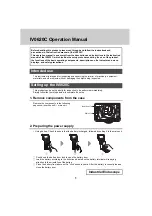
13 of 16
Entering and Exiting the Water:
Shore Diving
If you are facing a long walk just to get to the shore, the DOL-Fin X carries comfortably in
one hand much like a briefcase. There is enough room between the fin's suspension straps
to act as a finger hold. Also, the fin extensions on either side of the central support can
serve as a rack for your mask & snorkel and even a towel allowing you to offset the fin’s
weight and create a balanced handhold on the opposing fin extension. Everything you
need to go freediving can be transported in one hand as a single easy to carry package.
When shore diving, always assess conditions of entry and exit, waves, surge and current as
they can be dangerous and even deadly. Remember that the shoreline intersection of land,
sea and air can be one of the most violent environments on Earth.
When shore diving, the DOL-Fin should be carried into and out of the water. To make it
easier to put on, the heel straps should be lengthened prior to entering the water such that
you can quickly slip your feet into the foot straps and clip the heel strap buckles. Then, a
quick pull on the heel straps to take up the slack is all that is required to start swimming.
When conditions allow, you can then take the time to retighten the heel straps for optimum
connectivity and comfort and stow the heel straps by attaching the heel strap bungee to the
hook on the fairing as shown in figure 1. If conditions permit, the fin should be put on and
removed in water shallow enough to stand in. However, the DOL-Fin is put on and
removed while floating in a crowched position in the water with your feet pulled up of the
bottom.
Boat Diving:
When boat diving, it may be possible to use the rolling back entry. With this entry, the
DOL-Fin is secured to the swimmer’s feet while sitting on the edge of the boat where the
rolling back entry will be performed. With all gear set up and ready to go, the diver can
then roll back into the water and start swimming. Since all of the diver’s gear is ready
prior to entering the water this is the safest way to dive. Be sure that you have appropriate
clearances around you before starting your rolling back entry. You don’t want to injure
others as you roll back or get your fin caught on anything in the boat.
14 of 16
If the rolling back entry is not used, an entry similar to a shore diving entry can be used,
whereby the diver first enters the water and then dawns the monofin.
Never attempt to stand up on dry land with both feet engaged into the DOL-Fin as you will
be unstable which can cause you to fall and lead to injury. Never attempt to jump or dive
from the end of a platform, dock, diving board or similar structure with both feet engaged
in the DOL-Fin.
When exiting the water, as with other fins, the DOL-Fin should not be removed until the
swimmer has a firm hold of the boat or a safety line. Never leave yourself exposed to
water currents without an effective means of propulsion.
Care & Maintenance:
The DOL-Fin should be rinsed with fresh water after use to keep it clean and reduce
corrosion. Rinse the hollow sections of the High Aspect Ratio Fin and rinse the area
inside the fairing as well. The DOL-Fin should be stored out of direct sunlight to avoid
ultraviolet light degradation of materials.
Always perform a pre-dive checkout of the DOL-Fin before using it. See the “Pre-Dive
Checkout” section of this owner’s manual for the inspection checklist.
Replacement parts for your DOL-Fin can be ordered from Smith Aerospace Corp.
Fin Assembly:
The DOL-Fin series monofins incorporate large foldable performance enhancing raked fin
tips. An Orca with missing fin tips will suffer a significant performance penalty the Orca
with the fin tips installed. Damaged, deformed or misshapen fin tips can also affect and
degrade the fin’s performance and balance. It is important to maintain the fin tips in good
operating form for the fin to function properly and as designed.
The shape of the fin tips can be maintained by storing the monofin with tips extended in
swimming configuration and with the fin leaning against a wall with the trailing edge of
the fin on the floor and the top of the fairing against the wall as is shown in
Figure 6
. The
trailing edge of the foil resting on the floor will place an appropriate amount of curvature


























